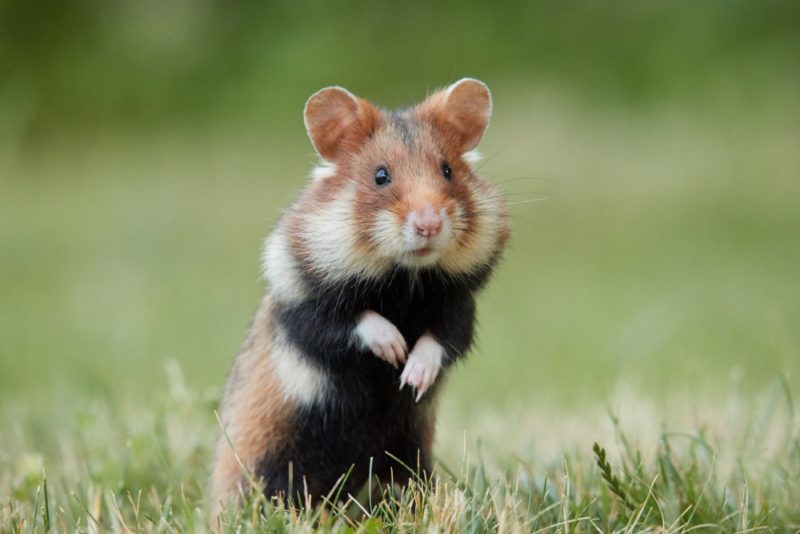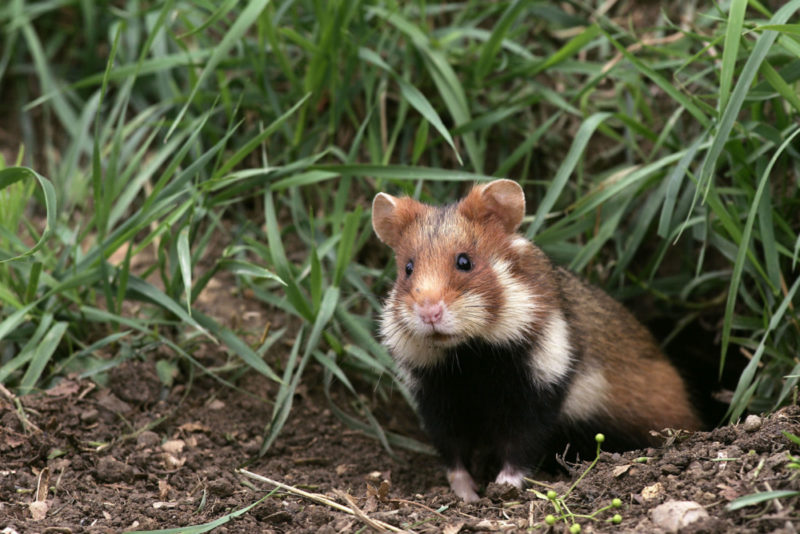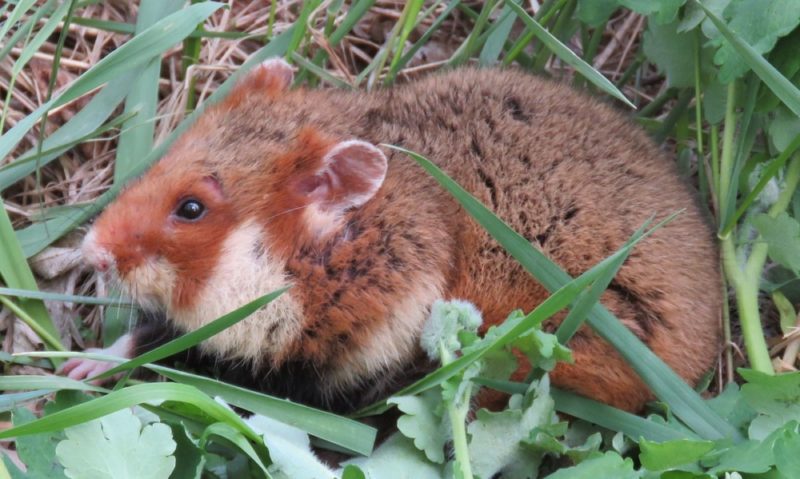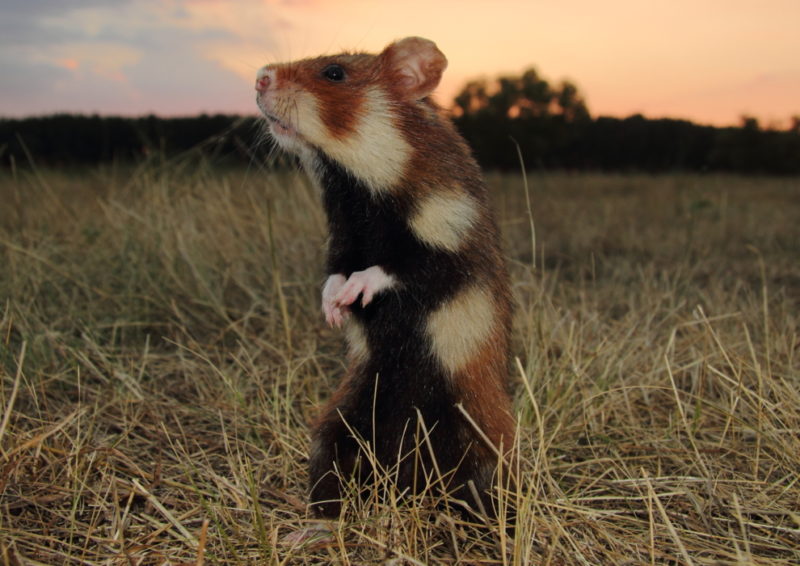An ordinary hamster is a smart, economic, neat animal that feels most comfortable in loneliness. It is important to understand that this is not a tame animal, so you can enjoy his company only from the outside.
Material Content:
Common Hamster Habitat
These animals are inhabitants of Eurasia. You will not meet them except in the forests, high in the mountains and in the swamps. They densely populated two zones - the steppe, forest-steppe. Hamsters and their minks can be seen not far from river valleys, in meadows, in the steppes, on the city outskirts, and even next to people - in gardens, parks, kitchen gardens. They can settle on hills - up to 1.5 km above sea level. A comfortable habitat for hamsters is lowlands. In areas with developed agriculture, these rodents are found everywhere. If a building or a village was erected in an area where previously there were fields (gardens) - ordinary hamsters can still live there.
Character, habits and lifestyle
Hamsters have many interesting habits. They are no less interesting externally. The description of the species includes the following characteristics: wide ears and feet, the tail is thickened at the base, developed claws, bright coat with white spots (black on the abdomen, red or brown on the back and sides).
These are "nocturnal" animals that prefer to rest in the light of the sun. They hunt at night, seek food and gather supplies for the winter. Hamsters almost do not interact with each other and with representatives of other species. These relationships are usually passive-aggressive. Spending all life alone, males and females unite only in the mating season. Hamsters to the last avoid collisions, which is an important mechanism for the survival of rodents. In nature, they can live up to 4 years of age.If a collision is inevitable, they boldly rush even at large enemies. At the moment of danger, it can also attack a person. At the same time, it looks intimidating: it stands on its hind legs, clicks its teeth, and approaches the enemy. Its opponents are predators: fox, eagle, eagle owl, owl, ermine, ferret.
Among all the relatives, the "ordinary" is the largest hamster (about 30 cm in length). Such a large rodent needs plenty of food. In his "house" there are always many cells for supplies. Mink is a storage room with tunnels and a nesting chamber. The “branch” hole can be 2 m deep into the earth, its length can reach 7-8 m. There are always several exits, sometimes 8-10. Tunnels perform different functions. Three types are distinguished among them: gently sloping exits, steep vertical entrances (convenient in case of danger), and walkways to the pantries.
In winter, all entrances and exits are tightly covered by ground. The mink floor is insulated with straw. In the pantry, the animal stores a large number of supplies - about 15 kg. There are known cases of the discovery of destroyed minks in which more than 90 kg of feed was stored - lentils, peas, beans, barley, and wheat. Everything was carefully sorted.
In the fall, “storages” are filled. In winter, the rodent hibernates. It interrupts sleep only to reinforce the stored food if the air temperature is above -20 degrees. The same stocks help him survive in the spring, when new feeds have not yet grown in the fields and gardens. During a warm, calm winter, he wakes up often, sometimes going outside. An ordinary hamster is extremely neat, never defecates in residential "premises" or chambers. To do this, he has allocated special restrooms. He occupies other people's homes very rarely. In this case, settles in the house of a gopher or other burrowing species.
Natural diet
The hamster is an omnivorous animal. As a rule, it feeds on different parts of plants. Can consume insects, small vertebrates, larvae. Most of the diet is made up of grain, fleshy roots, stems, and tubers. Their hamsters eat until autumn and collect for the winter. In the summer they like to nibble fresh leaves. Most often, minks are stored in the minks: corn, millet and other cereals. Legumes are also found there: lupine, peas. Also, an ordinary hamster can feast on potatoes, carrots.
Storerooms are filled neatly - a separate place is prepared for each type and grade. Hamster babies move to “adult” nutrition (plant foods, insects) at the age of 3 weeks.
To transfer food to bins, the hamster uses cheek pouches. Sometimes with them in a filled state, he walks several kilometers. Bags hold about 80 g of food.
Life span
This independent animal feels uncomfortable in captivity. Featuring good health, he often gets sick in the cell, becomes lethargic, sad. Life expectancy is reduced by 2 times. In the wild, the hamster lives up to 4 years (according to some versions - all 10). In conditions created by man, the animal does not live for more than 2 years. Even if this artificial environment is ideal and as close as possible to the natural environment. With improper care, the diet of the pet will live even less.
The species is protected in some European countries, in which its population has been greatly reduced. These countries include Germany, Belgium, Poland, France, the Netherlands, Belarus, Ukraine. The Red Book of Ukraine "protects" the rodent since 2009.
Breeding and offspring
Hamsters briefly create pairs twice a year. For mating, the male enters the female’s housing. If there he discovers another male rival, a violent clash begins. April-October is the mating and breeding season. The peak of the mating season is the end of spring. A female hamster hatches cubs on average 21 days. 10-20 animals are born at a time.
They are only next to their mother for the first three weeks. As soon as the kids switch to full-fledged adult nutrition, they leave their home.There are studies according to which the female pushes the kids out of the house in order to copulate with the next "groom". Her children begin an independent life in their minks. After that, mother and children do not support any communication.
Common hamster at home
It is worth considering, like many representatives of the hamster family, ordinary hamsters do not become manual until the end of their lives. Pets are in no hurry to contact the owner, choosing loneliness. But they are one of the most popular favorites that breed well in captivity. It is worth remembering the hibernation of the animal.
Rodents often damage furniture, appliances, wires to it, any home furnishings. Adult animals are unexpectedly unreasonably aggressive. Resentment pet "forgives" quickly, becoming peaceful, non-aggressive. Hamsters can be trained, quickly learn. They show good mood and disposition to communicate with the owner, for example, by actively jumping in the cell. This is a good signal, it is worth paying attention to the pet.
You should choose a spacious cage so that there is enough space for outdoor games. Ordinary hamsters cannot be placed in the same cage in pairs. An individual of the opposite sex is hooked up to the pet only for copulation.
Hamsters are not demanding on living conditions. The content of this species does not take much effort. You should not choose glass containers as a house for your pet. Ammonia, dust, carbon dioxide accumulate at their bottom.
It is important to place the cage at a height of half a meter from the floor. To make the pet more adaptable, the cage is covered with dense material (tissue). Also during this period it is not necessary to make noise next to the animal, to turn on bright light.
In the cell must be:
- litter (sawdust, odorless granules for rodents);
- bowls for food and a drinker;
- a house (where the animal can retire);
- rides (a wheel for running, labyrinths, bridges, ladders);
- a special mineral stone for grinding off rodent teeth (from the same stone it will receive useful minerals).
You can not cover the cage with newspapers, magazines, because the paint is harmful to hamsters. For bedding do not use very small filings that are dangerous to the health of the rodent. 2 feeders are placed in the cage - for wet food and for dry. The drinker is hung on the wall of the housing and regularly pour clean water.
It is necessary to care for the claws of the animal. The pet must regrow overgrown horn formations on its own. But if this does not happen - cut the claws or go to the veterinarian. At home, they do this carefully so as not to damage the paws and fingers of the animal. Hamsters do not bathe. Their wool is simply wiped with a damp cloth (in places of pollution) and dried.
Regular walking is required for the health of an ordinary hamster. Walking only in a specially designated area for this with a lawn, obstacles, houses, mini-beds.
Relationship with man
This is one of the main pests of the household, especially in rural areas. People who have gardens, gardens do not like hamsters. Rodents can destroy an entire crop. There are times when, due to the huge number of pest hamsters, they are hunting. Rodents can infect humans with tularemia, encephalitis.
Hamsters are very independent and freedom-loving animals. Their special character is important to respect.

















